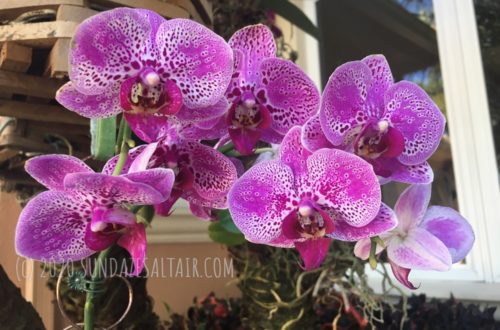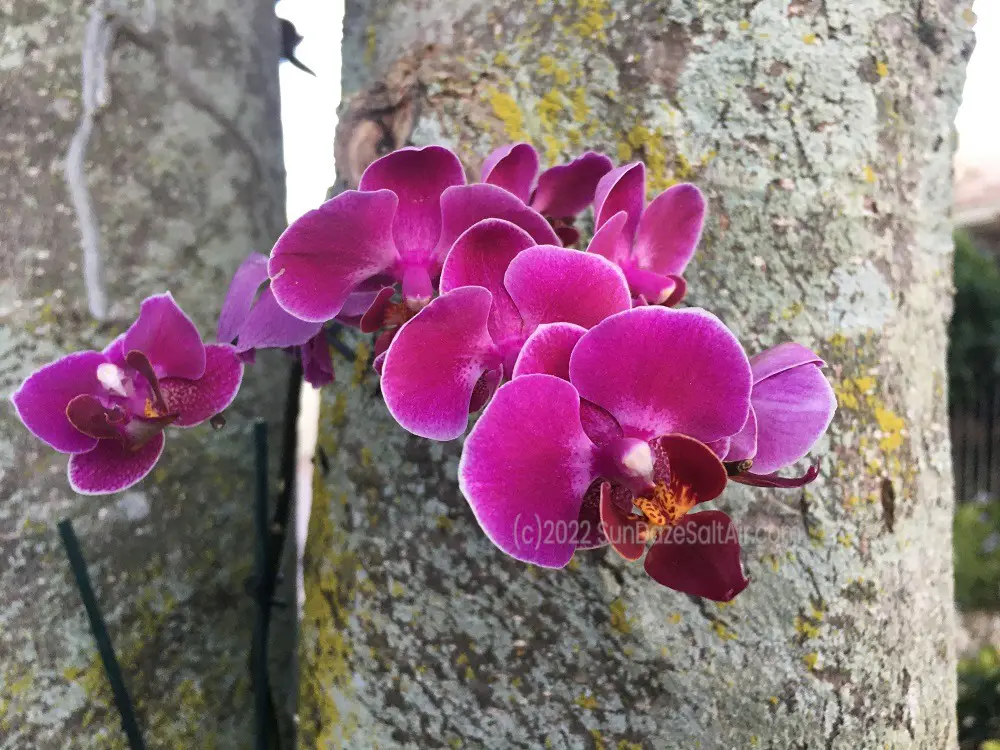
How to Attach A Phalaenopsis Orchid to A Tree
How to Mount & Grow Your Phalaenopsis Orchid On A Tree: Three Easy Methods
Phalaenopsis orchids are one of the most popular orchids around. Beautiful and tropical, these orchids grow naturally on trees in tropical and semi-tropical places. As epiphytes, Phalaenopsis orchids love living on tree bark in warm climates that mimic their native wild habitat. Just take a look at the photos on this page of lush, thriving orchids with long, robust root tips grabbing onto tree bark, and it is quickly apparent just how much orchids love growing on trees. Would you like to try growing your Phalaenopsis orchid in this rustic, natural style that promotes orchid growth and vitality? If so, keep on reading to learn how easy it is to attach and grow your Phalaenopsis orchid on a tree…
Where Can You Grow a Phalaenopsis Orchid on a Tree?
While you may have received your Phalaenopsis in a pot from a store, your orchid would much rather be on a tree in a rainforest. Even if you don’t live anywhere near a rainforest, I’m sure you can find some trees. And if you reside in the United States in USDA growing zones 10 through 12 you should be able to grow your Phalaenopsis orchids outside on trees with ease similar to how such orchids grow wild in their native habitat.
**Type in your zip code here to find out whether your growing zone supports growing orchids on trees.

Why Attach & Grow a Phalaenopsis Orchid on a Tree?
In the proper climate, trees supply a Phalaenopsis orchid with all of its essential needs. Growing outdoors on a tree provides optimal light and moisture, while also satisfying the Phalaenopsis orchid’s need for root ventilation. The tree bark and natural environment “fertilizes” the Phalaenopsis by supplying the nutrients it craves.
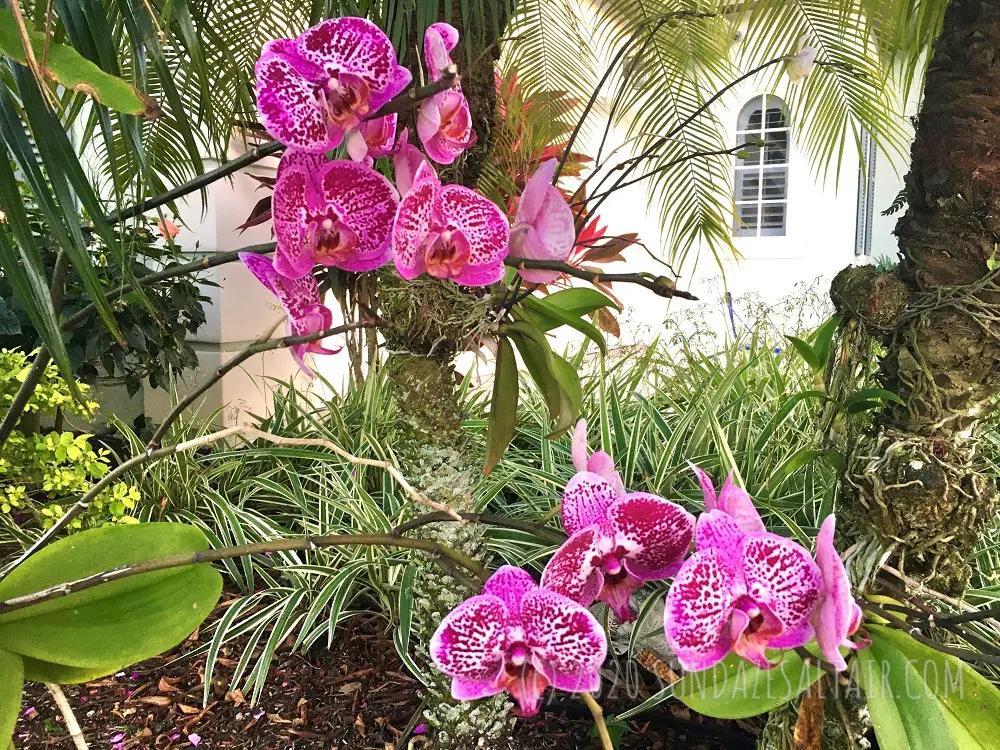
What Do You Need to Attach a Phalaenopsis Orchid to a Tree?
Supplies you will need:
- Phalaenopsis orchid with its potting mix carefully removed (find out how to repot a Phalaenopsis orchid here…);
- Your choice of: cotton twine, string, fishing line, green garden tape, a section of burlap or even knee-high panty hose to hold and secure your orchid to the tree;
- Scissors if you are using twine, string, line or garden tape;
- Heavy-duty stapler if you are using burlap;
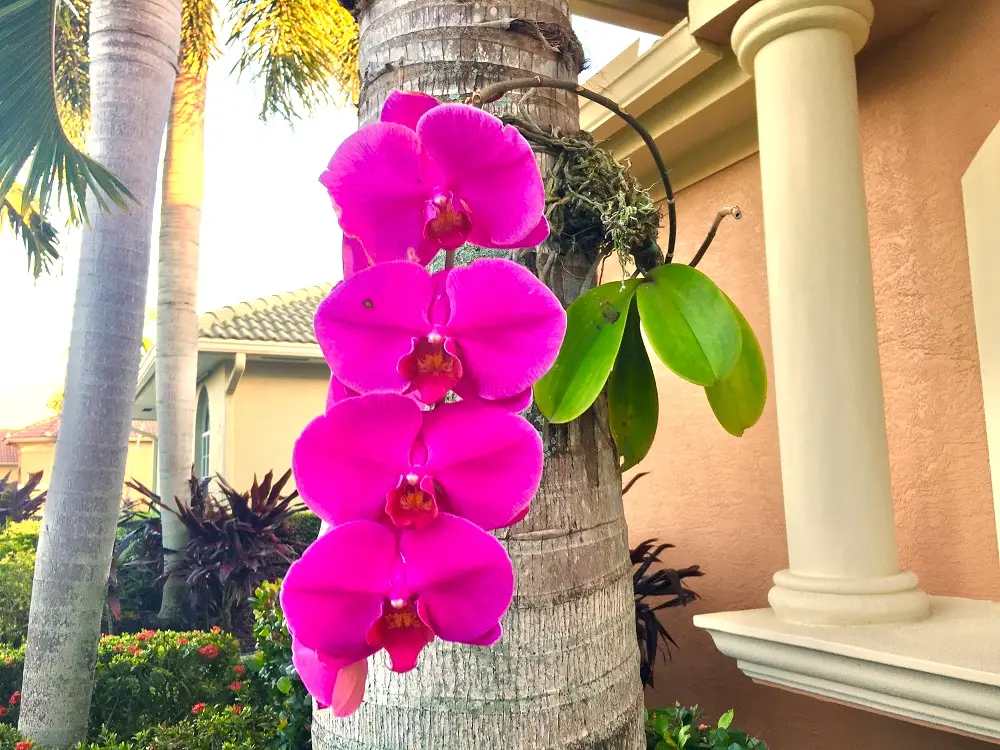
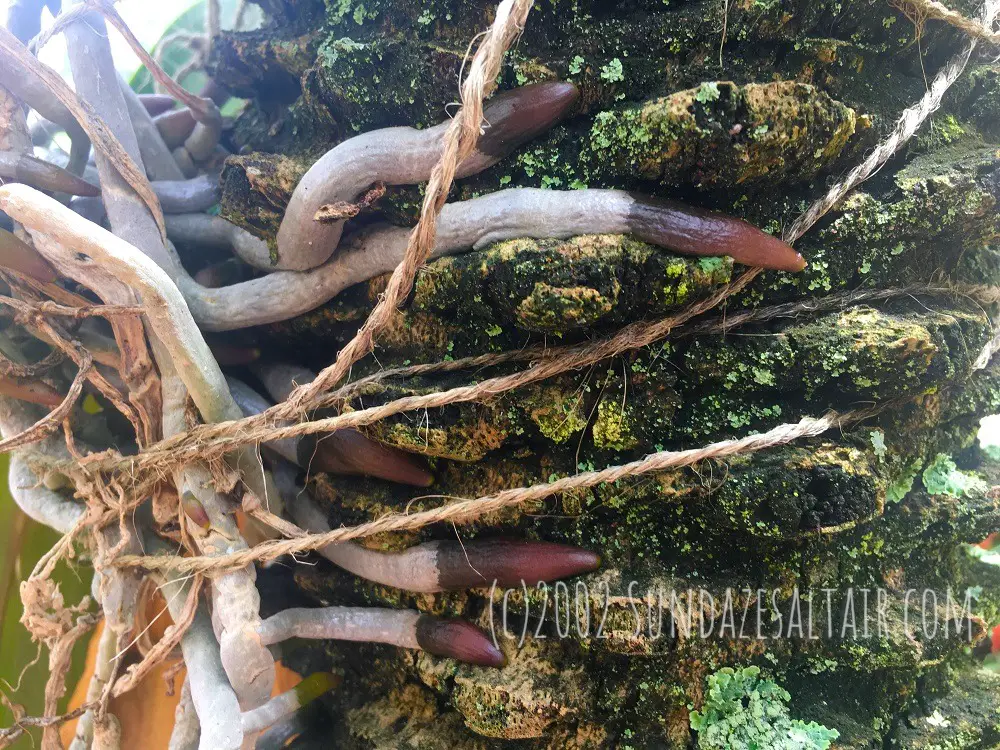
How to Attach a Phalaenopsis Orchid to a Tree: Prepare Your Orchid
1. Unpot Your Orchid.
If your Phalaenopsis is potted, it likely came with its roots tightly bound and encased in layers of sphagnum moss. You will want to carefully loosen the roots and dislodge any of the old potting material. To do so, wet and carefully peel away the layers of moss from between your orchid’s roots. **Read more about how to repot a Phalaenopsis orchid here…
**TIP! Detangling your orchid from its potting mix frees up your plant’s roots so they can attach to the tree. It also allows you to see what you are working with in terms of your Phael’s root condition and health.
2. Sphagnum Moss or No Sphagnum Moss? Use Sphagnum Moss with Caution
Sphagnum moss is often recommended for hydrating your orchid’s roots since it traps moisture but still dries out relatively fast. However, sphagnum moss does require caution since, in overly “wet” conditions, it can work too well at hydrating an orchid’s roots. If you have a mature orchid with many roots or if you live in a drier climate, sphagnum moss may help your orchids stay adequately hydrated. However, in consistently wet conditions or in the case of immature orchids with few roots, sphagnum moss can be too much of a good thing. So, in wet climates, or in the case of small orchids, delay using sphagnum moss until you are sure your orchids really need the extra hydration boost.
Let nature provide hydration in the form of rain and humidity, and then evaluate whether it needs any assistance in the form of sphagnum moss.
**TIP! Avoid Placing Any Medium Between Your Orchid’s Roots & the Tree
Another drawback of adding a layer of moss between your orchid’s roots and its tree, is that the roots may attach themselves more to the medium than the tree. This, of course, would reduce your orchid’s ability to cling to its tree host.
**Of course, due to its moisture-retaining abilities, in dry indoor conditions, sphagnum moss is frequently used as a potting medium. Keep reading if you want to learn the difference between sphagnum moss and Spanish moss, and why one is the far better choice for hydrating your orchids. If you want to skip ahead to attaching your orchid, scroll down to, “Which Method Is Best to Attach Your Orchid to Your Tree?“
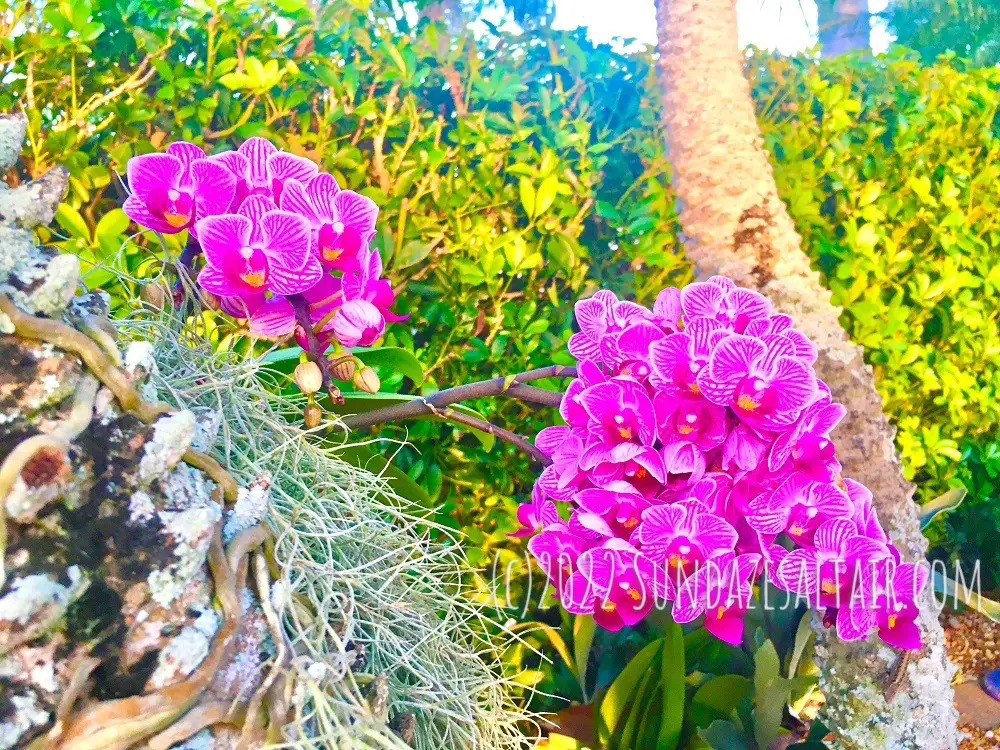
*********
Did You Know? Sphagnum Moss Vs. Spanish Moss: Important Considerations for Orchids
With their similar look and name, these two types of “moss” can easily be confused. Spanish moss is the grey-green, stringy hair-like plant you often see hanging from Cypress or Oak trees in the deep South. It is actually neither moss nor Spanish. Rather, it is a perennial herb in the pineapple family (!) that is native to Central and South America, as well as the Caribbean.
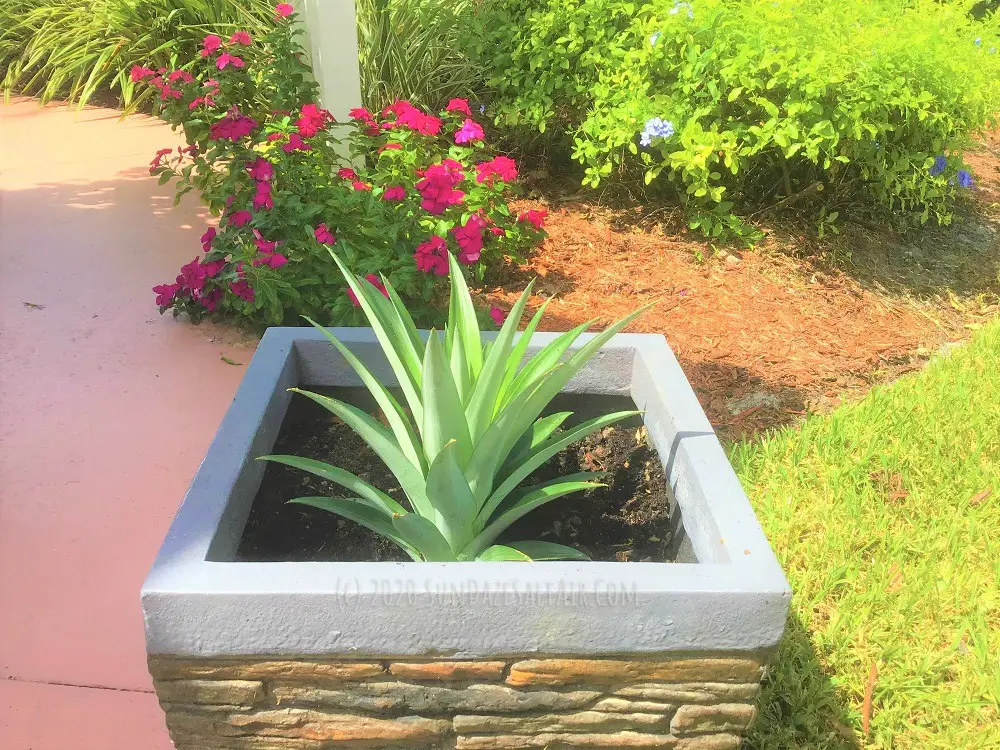
Choose Sphagnum Moss Over Spanish Moss for the Health of Your Orchid
Frequently depicted in creepy swamps and Southern Gothic imagery, these “swamp” associations are actually quite justified. Spanish moss is known for its ability to retain moisture and humidity even more so than Sphagnum moss. While this may seem ideal for certain types of orchids, Spanish moss tends to retain too much water which can induce rot quickly. This makes it dangerous kryptonite for potted plants, and especially sensitive orchid roots.
Sphagnum moss, in contrast, provides moisture, but dries out relatively fast, minimizing the potential for dangerous rot. However, as discussed above, in more humid locales, you may not need any additional moss to hydrate your orchid roots.
Bottom-line: Use Spanish Moss for Display Only
For these reasons, Spanish moss should only be used as a decorative top layer in your orchid displays, such as to hide any plastic ties, if you prefer. Just check it occasionally for disintegration.
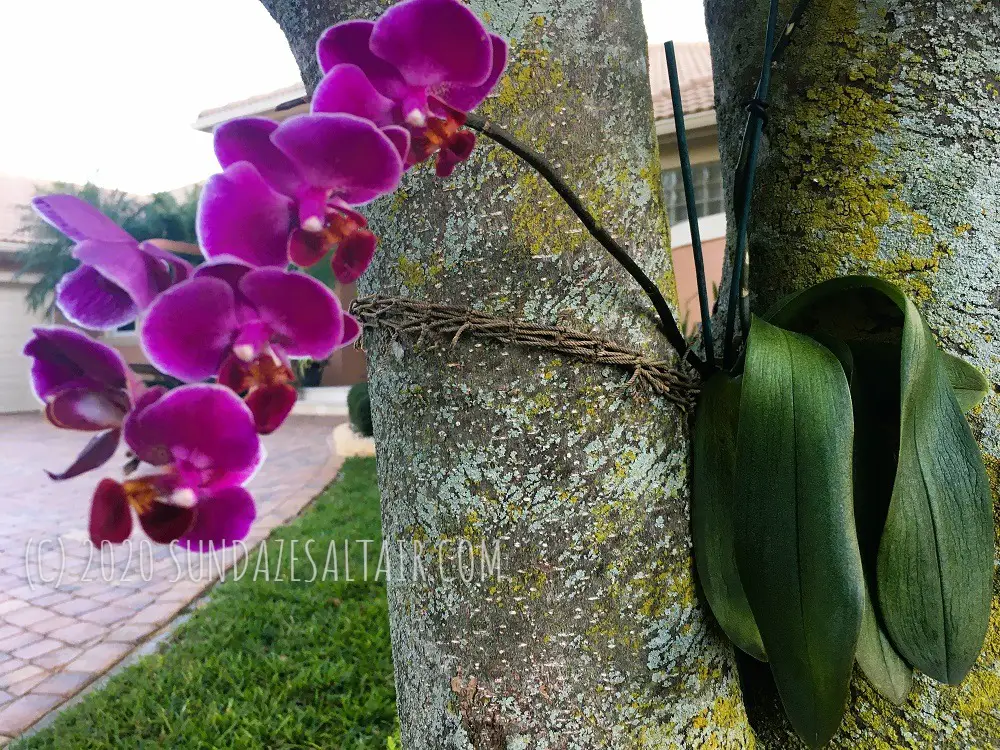
Which Method Is Best to Attach Your Orchid to Your Tree? Three Options for Mounting Your Phalaenopsis
There are three common methods for attaching a Phalaenopsis to a tree: tying it with some type of string or tape; stapling burlap over the roots; or tying it with knee-high panty hose. Lightweight burlap and knee-high panty hose will hold your orchid very securely. However, string, line and garden tape can also be very secure so long as you wrap it around a few times for best results. I usually use cotton string or garden tape since I always have some lying around, and I have always had excellent results.
Of the three different methods, all will get the job done, so it really is a matter of preference. Or, whatever you happen to have on-hand, but there are a few considerations…
Which Orchid Tie Methods Blend Into the Scenery? Which Options Are Biodegradable?
-
- All the options, from string to burlap to knee-high panty hose, should blend in with the natural scenery. Green garden tape will stand out, yet the bright green can complement the natural surroundings. If any tie is too conspicuous for your liking, you can always conceal it by wrapping some moss around the tie.
- Cotton string, twine and burlap are biodegradable and naturally disintegrate relatively fast. Knee-high panty hose, in contrast, which is made of conventional nylon, may fall apart but may also take longer to completely degrade. If you are concerned about plastics and their effect on the environment, choose fast-disintegrating cotton twine or burlap.
**TIP! Your Orchid’s Roots Will Attach Themselves to the Tree
No need to worry too much about the appearance of string or knee-high panty hose, as you will eventually be able to remove them once your orchid attaches its roots to its tree. As discussed above, cotton string disintegrates, but plastic or fishing line will not disappear on its own. Instead, you can cut, remove and recycle any plastic line once your orchid’s roots have securely attached themselves.
Choose Your Tree to Attach Your Phalaenopsis
Select your tree of choice. You can read more about choosing a tree here at How to Mount Or Attach Your Vanda Orchid to a Tree & Why You Should Grow Orchids On Trees. Also, discover which side of the tree is best to mount or attach your orchid to and why it makes a difference on the bottom of this page.
Position Your Phalaenopsis
- Position your orchid’s roots up against the tree in your chosen location so the roots can eventually wrap themselves around it. Any orchid leaves or flower stem should point away from the tree.
**TIP! Enlist a Friend
It’s not necessary, but if you are using string or twine, an extra set of hands from a friend may come in “handy” to hold your orchid against the tree while you tie it.
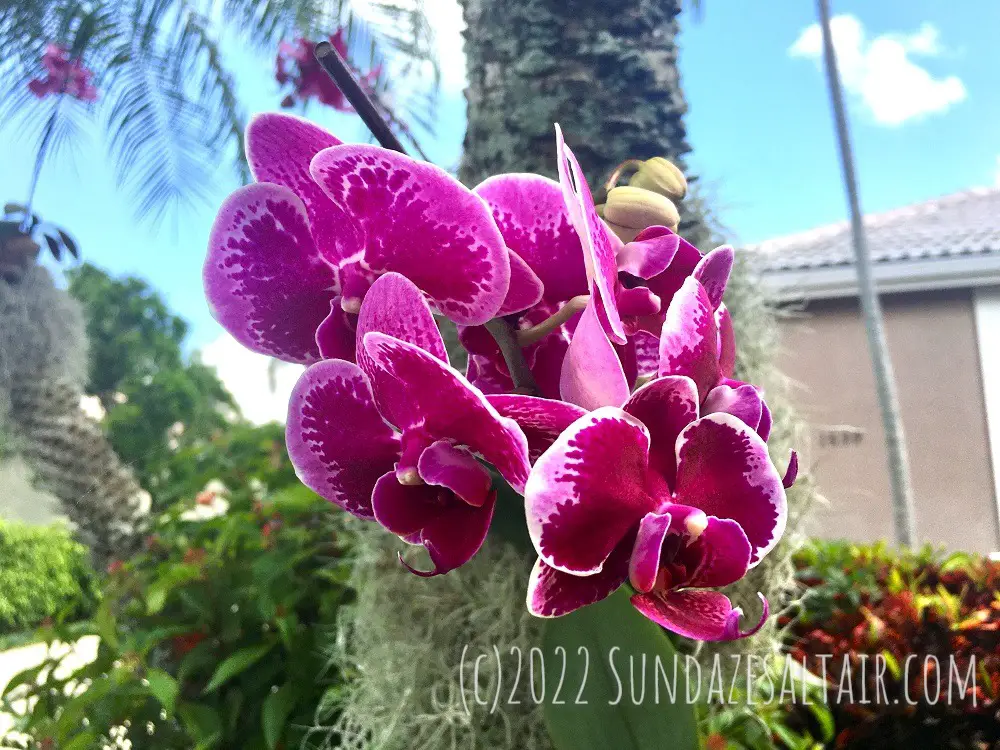
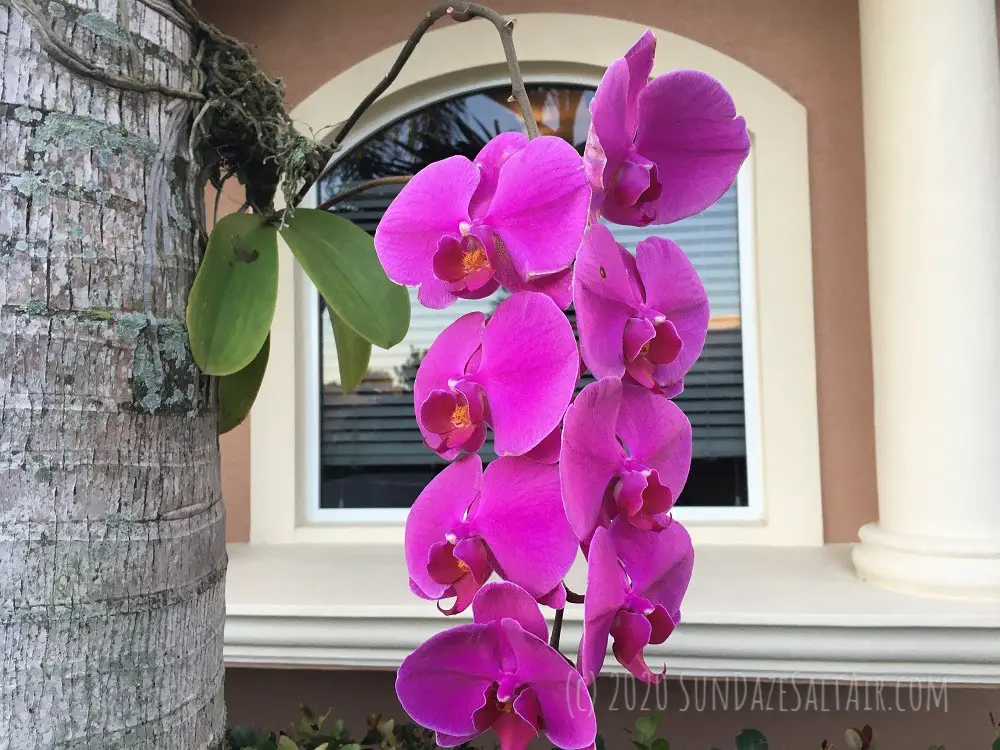
Attach Your Phalaenopsis to a Tree Using One of Three Mounting Methods
Method #1. Using String, Twine, Tape or Line:
- When using cotton twine, string, tape or fishing line, you may have to wrap it two or three times around the orchid’s roots (near the stem) and the tree to adequately hold everything in place. Cut off enough string to wrap at least two times around your orchid. Position your orchid with its inner roots facing the tree and its leaves and flower stem pointing away from the tree, as pictured in the image above.
- Tie the ends sufficiently snug so it is secure enough to withstand winds and whatever storms Mother Nature delivers without blowing away. In time, the interior roots that face the tree will eventually latch onto the bark, and you can cut and remove the ties that bind.
Method #2. Using the Knee-High Panty Hose Method:
- If you use the “knee-high panty hose method,” you can cut a small slit in the center of the knee-high to create a pocket to hold the exterior side of the roots.
- Position your orchid so interior roots are on the tree and its leaves and flower stem face away.
- Wrap both ends of the knee-high around the circumference of the tree and tie them a few times so it is snug, secure and the inner roots are against the tree. The panty hose will allow “breathability” so the roots are ventilated. In time, the roots will eventually latch onto the bark so you can cut away and remove the knee-high.
Method #3. Using the Burlap Method:
- If you are using a small section of burlap, wrap it over the outside orchid roots. Then, either wrap your tie of choice a few times around to fasten everything snug against the tree or use a construction stapler to staple the burlap to the tree. Yes, you can staple the burlap to the tree without causing any harm.
- Check that your orchid is held in place sufficiently tight to withstand windstorms without blowing off. As with the other methods, in time, the roots will wrap themselves around the tree, and you can remove the burlap.
Conclusion: How to Attach a Phalaenopsis Orchid to a Tree? Easy! Just Bookmark & Share These Tips
Now, you know how easy it is to attach and grow your Phalaenopsis orchid on a tree. Pick your favorite method or try all three of them to see which one works best for you. You may need to experiment with trees, location and sun exposure until you get your ideal Phalaenopsis orchid growing conditions.
Consider it part of the exciting journey to a tropical-inspired oasis where your trees become a lush and magical garden of hanging orchid blossoms…
Don’t forget to bookmark & share this page to inspire others in their gardening adventures!
********
Do you grow your Phalaenopsis orchids on trees in your garden? Share your experience growing magnificent orchids in the comments!


You May Also Like

How To Grow Your Own Easy Mint Container Herb Garden For Fresh Herbs At Home — Plus Mint Legend & Lore & Delicious Mint Recipes
July 31, 2020
How To Grow Potatoes in A Bag Easily in Small Spaces & Turn 3 Potatoes Into 30! Step-By-Step
July 13, 2021